WS2812RGB燈帶
通過零知標(biāo)準(zhǔn)開發(fā)板平臺(tái)上驅(qū)動(dòng)WS2812RGB燈珠,包括WS2812B的供電電壓、接線和代碼實(shí)現(xiàn)。通過創(chuàng)建延時(shí)函數(shù)和設(shè)置級(jí)聯(lián)數(shù)據(jù),實(shí)現(xiàn)對(duì)RGB燈珠的控制,展示了從關(guān)閉到開啟不同顏色以及跑馬燈、呼吸燈和彩虹燈等效果。
一、工具原料
電腦、Windows系統(tǒng)
零知開發(fā)板
Micro-usb線
WS2812RGB燈
二、硬件連接
| 零知標(biāo)準(zhǔn)開發(fā)板 | WS2812B |
| 5V | VCC |
| GND | GND |
| 11 | Din |
硬件連接示意圖
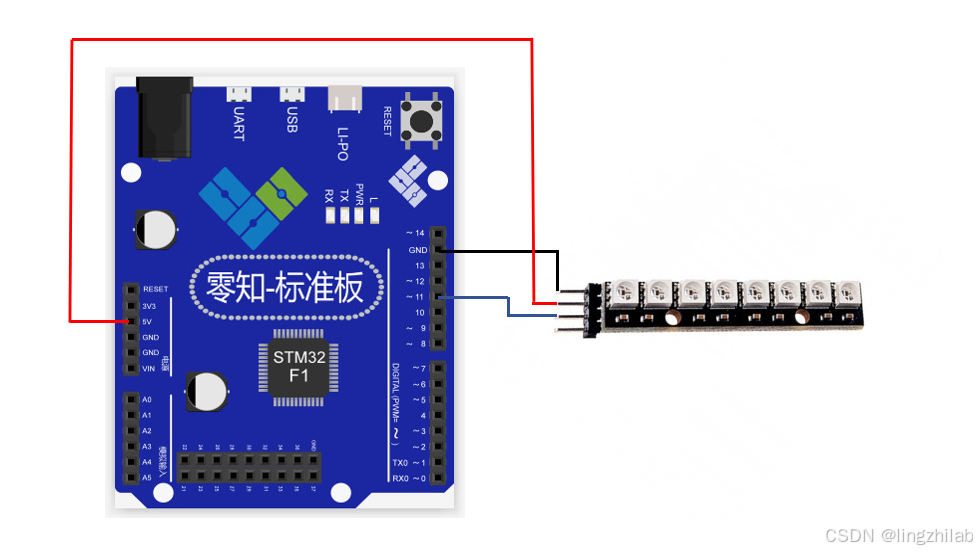
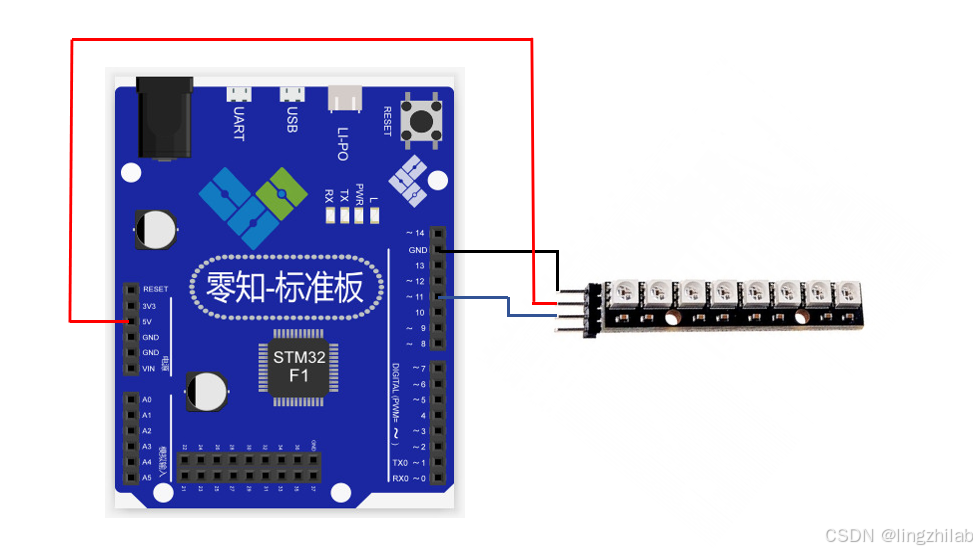
實(shí)際連接
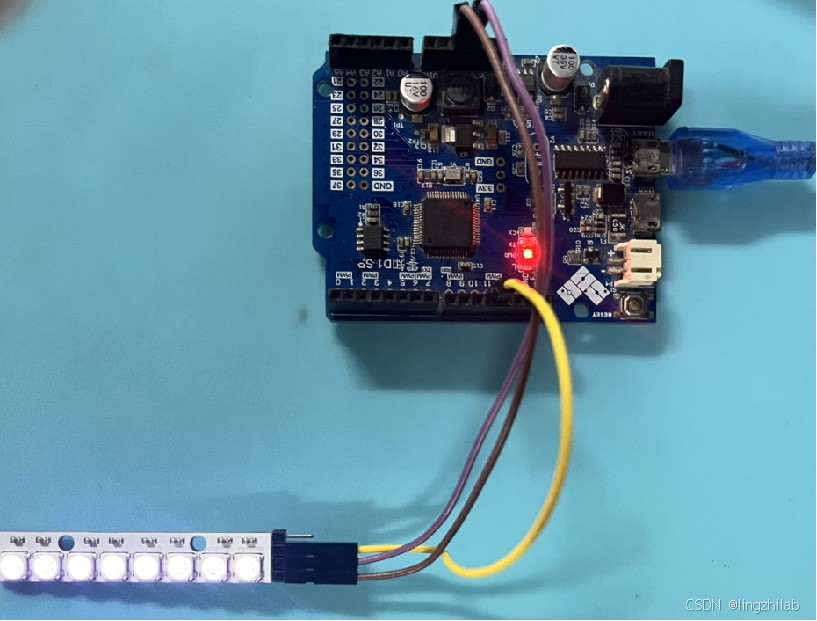

三、方法步驟
1、打開零知實(shí)驗(yàn)室軟件開發(fā)工具,然后新建項(xiàng)目,輸入代碼
2、將庫文件解壓放到庫文件存放的目錄下
3、選擇端口進(jìn)行編譯,然后上傳到開發(fā)板中。
引用庫文件WS2812B.h
?#include // 引入用于控制WS2812B LED燈帶的庫 #define NUM_LEDS 9 // 定義燈帶上的LED數(shù)量 #define DELAYVAL 500 // 定義延遲時(shí)間(單位:毫秒),用于在不同效果之間的暫停時(shí)間 /* * 注意:該庫使用SPI1進(jìn)行數(shù)據(jù)傳輸 * 將WS2812B的數(shù)據(jù)信號(hào)輸入引腳連接到開發(fā)板的MOSI引腳。 */ WS2812B strip = WS2812B(NUM_LEDS); // 創(chuàng)建一個(gè)WS2812B對(duì)象,用于控制燈帶
設(shè)置SPI、點(diǎn)亮不同效果的RGB燈
// 請注意。庫中并不真正支持Gamma,它只是在本例中使用的一些函數(shù)需要Gamma時(shí)才包含
uint8_t LEDGamma[] = {
0, 0, 0, 0, 0, 0, 0, 0, 0, 0, 0, 0, 0, 0, 0, 0,
0, 0, 0, 0, 0, 0, 0, 0, 0, 0, 0, 0, 1, 1, 1, 1,
1, 1, 1, 1, 1, 1, 1, 1, 1, 2, 2, 2, 2, 2, 2, 2,
2, 3, 3, 3, 3, 3, 3, 3, 4, 4, 4, 4, 4, 5, 5, 5,
5, 6, 6, 6, 6, 7, 7, 7, 7, 8, 8, 8, 9, 9, 9, 10,
10, 10, 11, 11, 11, 12, 12, 13, 13, 13, 14, 14, 15, 15, 16, 16,
17, 17, 18, 18, 19, 19, 20, 20, 21, 21, 22, 22, 23, 24, 24, 25,
25, 26, 27, 27, 28, 29, 29, 30, 31, 32, 32, 33, 34, 35, 35, 36,
37, 38, 39, 39, 40, 41, 42, 43, 44, 45, 46, 47, 48, 49, 50, 50,
51, 52, 54, 55, 56, 57, 58, 59, 60, 61, 62, 63, 64, 66, 67, 68,
69, 70, 72, 73, 74, 75, 77, 78, 79, 81, 82, 83, 85, 86, 87, 89,
90, 92, 93, 95, 96, 98, 99,101,102,104,105,107,109,110,112,114,
115,117,119,120,122,124,126,127,129,131,133,135,137,138,140,142,
144,146,148,150,152,154,156,158,160,162,164,167,169,171,173,175,
177,180,182,184,186,189,191,193,196,198,200,203,205,208,210,213,
215,218,220,223,225,228,231,233,236,239,241,244,247,249,252,255 };
void setup()
{
strip.begin();// 設(shè)置SPI
strip.show();// 清除strip,因?yàn)槟J(rèn)情況下條帶數(shù)據(jù)設(shè)置為所有LED關(guān)閉。
// strip.setBrightness(8);
}
void loop() {
// 實(shí)現(xiàn)不同的燈光效果
colorWipe(strip.Color(0, 255, 0), 20); // 使用綠色逐個(gè)點(diǎn)亮燈帶
colorWipe(strip.Color(255, 0, 0), 20); // 使用紅色逐個(gè)點(diǎn)亮燈帶
colorWipe(strip.Color(0, 0, 255), 20); // 使用藍(lán)色逐個(gè)點(diǎn)亮燈帶
rainbow(10); // 顯示彩虹漸變效果
rainbowCycle(10); // 顯示循環(huán)的彩虹效果
theaterChase(strip.Color(255, 0, 0), 20);
theaterChase(strip.Color(0, 255, 0), 20);
theaterChase(strip.Color(0, 0, 255), 20);
theaterChaseRainbow(10);
whiteOverRainbow(20, 75, 5); // 白光覆蓋在彩虹效果上
fullWhite(); // 將燈帶上的所有LED點(diǎn)亮為白光
delay(250); // 暫停250毫秒
rainbowFade2White(3, 3, 1); // 彩虹效果逐漸過渡到白光
theaterChaseWhiteAndOff(DELAYVAL); // 實(shí)現(xiàn)白光追逐與關(guān)閉的效果
delay(250);
flowingLight(100); // 實(shí)現(xiàn)流動(dòng)光效果,速度為100ms
breathLight(255, 50); // PWM呼吸燈效果
}
將呼吸燈、彩虹燈和流水燈等功能的庫函數(shù)封裝
void breathLight(uint8_t maxBrightness, uint8_t speed) {
// 實(shí)現(xiàn)PWM呼吸燈效果
for (uint8_t brightness = 0; brightness <= maxBrightness; brightness++) {
for (uint16_t i = 0; i < strip.numPixels(); i++) {
// 設(shè)置每個(gè)LED的顏色,使用伽馬校正后的亮度值
strip.setPixelColor(i, strip.Color(LEDGamma[brightness], LEDGamma[brightness], LEDGamma[brightness]));
}
strip.show();
delay(speed); // 延遲以實(shí)現(xiàn)亮度變化
}
for (uint8_t brightness = maxBrightness; brightness > 0; brightness--) {
for (uint16_t i = 0; i < strip.numPixels(); i++) {
strip.setPixelColor(i, strip.Color(LEDGamma[brightness], LEDGamma[brightness], LEDGamma[brightness]));
}
strip.show();
delay(speed);
}
}
void flowingLight(uint8_t speed) {
// 實(shí)現(xiàn)流動(dòng)光效果
uint16_t index = 0; // 記錄當(dāng)前流動(dòng)的索引
uint8_t currentColor = 0; // 記錄當(dāng)前的顏色(紅、綠、藍(lán))
while (true) {
for (uint16_t i = 0; i < NUM_LEDS; i++) {
// 根據(jù)當(dāng)前索引計(jì)算目標(biāo)索引
uint16_t targetIndex = (i + index) % NUM_LEDS;
switch (currentColor) {
case 0:
strip.setPixelColor(targetIndex, strip.Color(255, 0, 0)); // 設(shè)置為紅色
break;
case 1:
strip.setPixelColor(targetIndex, strip.Color(0, 255, 0)); // 設(shè)置為綠色
break;
case 2:
strip.setPixelColor(targetIndex, strip.Color(0, 0, 255)); // 設(shè)置為藍(lán)色
break;
}
strip.setPixelColor(i, strip.Color(0, 0, 0)); // 將之前的LED關(guān)閉
strip.show();
delay(speed);// 設(shè)置流動(dòng)光的速度
}
// 切換到下一個(gè)顏色
currentColor = (currentColor + 1) % 3;
// 增加索引,實(shí)現(xiàn)流動(dòng)效果
index++;
if (index >= NUM_LEDS) {
index = 0; //重置索引
}
}
}
void theaterChaseWhiteAndOff(uint8_t wait) {
for (int j = 0; j < 10; j++) { // 10 cycles of chasing
for (int q = 0; q < 3; q++) {
for (uint16_t i = 0; i < strip.numPixels(); i = i + 3) {
strip.setPixelColor(i + q, (j % 2 == 0 ? strip.Color(128, 0, 128) : 0));
}
strip.show();
delay(wait);
for (uint16_t i = 0; i < strip.numPixels(); i = i + 3) {
strip.setPixelColor(i + q, 0); // Turn every third pixel off
}
}
}
}
// Fill the dots one after the other with a color
void colorWipe(uint32_t c, uint8_t wait)
{
for(uint16_t i=0; i= 0 ; j--){ // 亮度從255漸變回0
for(uint16_t i=0; i 255 - fadeMax){
// 最后一次循環(huán),亮度逐漸減少
fadeVal--;
}
strip.show();
delay(wait);
}
}
delay(500);
for(int k = 0 ; k < whiteLoops ; k ++){ // 循環(huán)執(zhí)行白色漸變效果
for(int j = 0; j < 256 ; j++){
for(uint16_t i=0; i < strip.numPixels(); i++) {
strip.setPixelColor(i, strip.Color(LEDGamma[j],LEDGamma[j],LEDGamma[j] ) );
}
strip.show();
delay(wait);
}
delay(2000);
for(int j = 255; j >= 0 ; j--){
for(uint16_t i=0; i < strip.numPixels(); i++) {
strip.setPixelColor(i, strip.Color(LEDGamma[j],LEDGamma[j],LEDGamma[j] ) );
}
strip.show();
delay(wait);
}
}
}
void whiteOverRainbow(uint8_t wait, uint8_t whiteSpeed, uint8_t whiteLength ) {
// 功能:在彩虹背景上疊加白色的流動(dòng)效果
// 參數(shù):
// wait - 動(dòng)畫更新間隔
// whiteSpeed - 白色流動(dòng)速度
// whiteLength - 白色光束長度
if(whiteLength >= strip.numPixels()) whiteLength = strip.numPixels() - 1;
int head = whiteLength - 1;
int tail = 0;
int loops = 3;
int loopNum = 0;
static unsigned long lastTime = 0;
while(true){
for(int j=0; j= tail && i <= head) || (tail > head && i >= tail) || (tail > head && i <= head) ){
// 如果在白色光束范圍內(nèi),設(shè)置為白色
strip.setPixelColor(i, strip.Color(255,255,255 ) );
}
else{
// 否則,根據(jù)j值設(shè)置彩虹顏色
strip.setPixelColor(i, Wheel(((i * 256 / strip.numPixels()) + j) & 255));
}
}
if(millis() - lastTime > whiteSpeed) {
head++;
tail++;
if(head == strip.numPixels()){
loopNum++;
}
lastTime = millis();
}
if(loopNum == loops) return;
head%=strip.numPixels();
tail%=strip.numPixels();
strip.show();
delay(wait);
}
}
}
void fullWhite() {
// 功能:點(diǎn)亮所有LED為白色
for(uint16_t i=0; i> 16);
}
// green 函數(shù): 提取顏色值中的綠色分量
// 參數(shù):
// c: RGB 顏色值(32 位整數(shù))
// 返回值:
// 綠色分量(0-255)
uint8_t green(uint32_t c) {
return (c >> 8);
}
// blue 函數(shù): 提取顏色值中的藍(lán)色分量
// 參數(shù):
// c: RGB 顏色值(32 位整數(shù))
// 返回值:
// 藍(lán)色分量(0-255)
uint8_t blue(uint32_t c) {
return (c);
}
四、成果展示
將上述代碼驗(yàn)證后上傳到零知板,就可以看到測試結(jié)果,實(shí)現(xiàn)流水燈、彩虹燈和呼吸燈等效果
?https://live.csdn.net/v/435823?spm=1001.2014.3001.5501
審核編輯 黃宇
-
開源
+關(guān)注
關(guān)注
3文章
3624瀏覽量
43536 -
開發(fā)板
+關(guān)注
關(guān)注
25文章
5565瀏覽量
102750
發(fā)布評(píng)論請先 登錄
什么是WS2812B?WS2812B燈帶是怎么連接的呢?

零知開源——玩轉(zhuǎn)WS2812B燈條模塊
零知開源——使用 GPIO 模擬時(shí)序驅(qū)動(dòng) WS2812B LED 燈帶
WS2812B RGB全彩LED燈珠
用ws2812b led燈條做遠(yuǎn)程區(qū)域面板控制器的教程
使用WS2812b Led燈條的diy光劍光劍控制器
使用WS2812B實(shí)現(xiàn)一個(gè)帶有麥克風(fēng)的RGB LED燈條控制電路
Arduino WS2812B LED燈帶設(shè)計(jì)方案
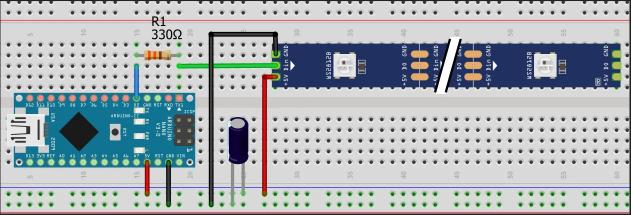
ESP32 WS2812b分線板開源分享

使用WS2812b Led燈條的diy光劍控制器

WS2812B RGB LED亮度控制和混色開源分享

迷你乒乓球含Arduino Nano WS2812B LED燈條

零知開源——使用 GPIO 模擬時(shí)序驅(qū)動(dòng) WS2812B LED 燈帶
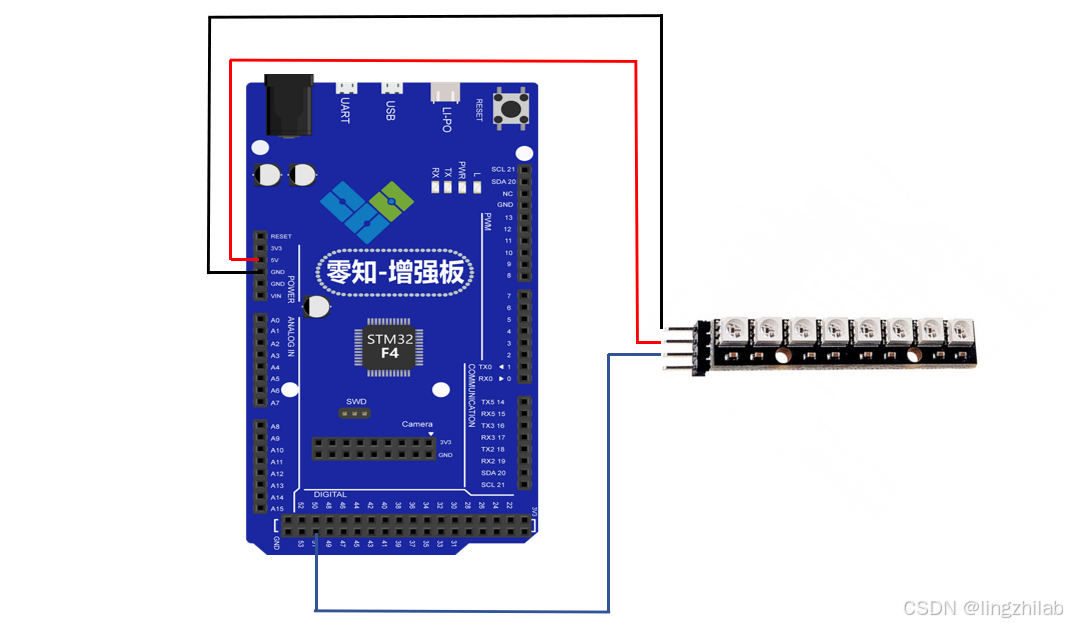





 零知開源——玩轉(zhuǎn)WS2812B燈條模塊
零知開源——玩轉(zhuǎn)WS2812B燈條模塊










評(píng)論